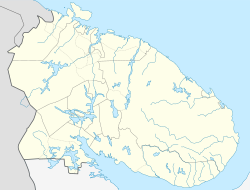Nikel
| Urban-type settlement
Nikel
Никель
|
||||||||||||||||||||||||||||||||||
|
||||||||||||||||||||||||||||||||||
|
||||||||||||||||||||||||||||||||||
| List of large settlements in Russia | ||||||||||||||||||||||||||||||||||
Nikel ( Russian Никель ; historically Finnish Kolosjoki ; German also Nickel ) is an urban-type settlement in the far west of Murmansk Oblast in northwestern Russia . Nikel is the administrative headquarters of the Rajons Petschengski and located seven kilometers from the Norwegian border and about 200 kilometers northwest of Oblastzentrums Murmansk . The settlement has 12,756 inhabitants (as of October 14, 2010).
The main industry of Nikels is the exploitation of the regional nickel deposits , which gave the place its name. The promotion is carried out by the Nornickel Group , which is also the world market leader in nickel production. The industrial activity in the surrounding area has led to extensive forest death.
history
The place was created during the affiliation of the area to Finland in 1935 under the name Kolosjoki in connection with the development of the ore deposits there by Petsamon Nikkeli Oy, which was controlled by the Inco via the British Mond Nickel Co. In the following years the construction of a railway line for the transport of the ore to the port of Liinahamari on the Barents Sea began.
In the Winter War from 1939 to 1940 the Soviet Union occupied all Petsamo (the Pechenga -type region); with the following peace agreement, however, only the Finnish part of the Rybatschi Peninsula was ceded to the Soviet Union, so that Kolosjoki initially remained with Finland.
In the summer of 1940 the Finnish government took over the mines from the British company. Ore mining began in the same year. The ore would mainly be sold to Germany , where it played an important role in the armaments industry. The hydroelectric power station in Jäniskoski went into operation in 1942 and made it possible to smelt the ore on site.
In December 1943, the German Minister of Armaments and Ammunition Albert Speer flew to Kolosjoki, the only nickel supplier for the German Reich at the time, in order to organize an accelerated removal of the raw material essential for the German war economy.
In 1944 the Red Army occupied Petsamo again, and Finland had to cede the entire area to the Soviet Union under the armistice signed by Moscow on September 19, 1944 . During their retreat, the German troops destroyed the power plant and some of the iron and steel works .
On July 21, 1945, the Presidium of the Supreme Soviet of the Soviet Union decided to incorporate the former Petsamo as the Pechengsky rajon of the Murmansk Oblast. The administrative center was Kolosjoki, renamed Nikel , which was given the status of an urban-type settlement on November 27, 1945. The steelworks went back into operation in 1946.
- Population development
| year | Residents |
|---|---|
| 1959 | 16.305 |
| 1970 | 21,299 |
| 1979 | 20,031 |
| 1989 | 21,838 |
| 2002 | 16,534 |
| 2010 | 12,756 |
Note: census data
Personalities
- Timofey Bukharin, musician, Wonders of Nature project
Web links
Individual evidence
- ↑ a b Itogi Vserossijskoj perepisi naselenija 2010 goda. Tom 1. Čislennostʹ i razmeščenie naselenija (Results of the All-Russian Census 2010. Volume 1. Number and distribution of the population). Tables 5 , pp. 12-209; 11 , pp. 312–979 (download from the website of the Federal Service for State Statistics of the Russian Federation)




